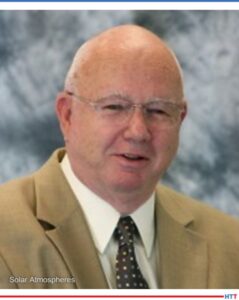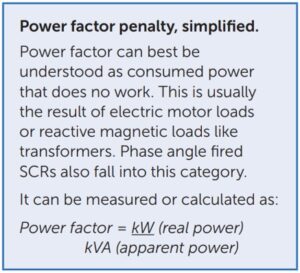Generally, electric power consumption is insidious, because it is not seen and is not considered enough by operating personnel. Uncover sources of power consumption at a typical heat treat plant and ways to conserve it.
This column is written by William Jones, CEO and founder/owner of Solar Atmospheres Group of Companies, and Roger A. Jones, CEO Emeritus at Solar Atmospheres, Souderton, PA, and appeared in Heat Treat Today’s June 2023 Heat Treat Buyers Guide print edition.
If you have suggestions for topics you’d like to see in the future, please email Bethany@heattreattoday.com.

CEO and Founder/Owner, Solar Atmospheres
Generally, electric power consumption is insidious, because it is not seen and is not considered enough by operating personnel. The following is a summary of power consumed in a typical heat treat plant along with several ways to conserve power (and money) in operating costs.
Electric Motors

CEO Emeritus, Solar Atmospheres, Souderton, PA
Electric motors are prolific throughout a heat treat plant. Some areas where they would be found include:
- Water recirculation pumps for cooling purposes
- Vacuum pumps
- Circulation pumps for oil used in quench tanks
- Fans
- Quench motors
High Vacuum Diffusion Pumps
High vacuum diffusion pumps operate with no noise, which adds to the insidious nature of their power consumption; operating costs for these pumps are more or less “out of sight.” To ensure diffusion pumps are not increasing costs, confirm that all diffusion pumps are set to run on the ConserVac® settings with full power (all three phases on) during high vacuum cycle and partial pressure cycles running on half power (one or two phases off). When possible, turn off/ shut down the diffusion pump.
Variable speeds of gas blowers can decrease power consumption, especially at the end of a cooling cycle when the heat of compression is noticeable. To do this, program all quench cycles to shut down the blower at the lower temperature as required on the work thermocouples (i.e., 125°F) and do not run blowers for excess time.
Building/Office Lighting, AC, and Heating
There’s more to saving than just focusing on vacuum equipment. Consider the following list of ways to reduce everyday power consumption:
- Turn off all office and shop lights when not needed, except for night lights. Make sure all office lights are off during non-working hours and weekends.
- Use newer, high efficiency type building lights.
- Program office heating and air conditioning for setback, like office lighting.
Lesson to be learned: turn off any electric motor or light whenever it is not in operation.
Costs of Running Electric Motors @ 10 cents/KWh
Furnace Heating Rate
No furnace should be heated any faster than 15°F to 30°F/minute or 900°F to 1800°F/hour, unless specific instructions mandate otherwise.
Scheduling and Power Demand
Understanding the utility company, peak times for electricity usage, and scheduling appropriately can decrease energy consumption and cost. The following are a few suggestions to direct thinking around scheduling and power demand:
- Utility company provides an electric power meter for kWh and demand kVA
- Meter contains a power demand register
- Record of electric power usage over a specific time increment
- Instantaneous demand peak recorded each month
- Result is the total kW hours registered in one part of the bill and the second part of the bill is kW electrical power demand
- Ideal situation: instantaneous power demand would be flat with no demand peaks for the month, but this is not the norm
- Batch type electric furnaces can produce major demand peaks:
- Major electric power savings are possible if equipment can be controlled so the peak demands can be staged, i.e., over several furnaces
- Schedule heavy production cycles to “off peak hours” usually during the evening, i.e., after 6 pm to 8 pm
- Some utility companies will not penalize for the demand factor during “off peak hours”
- Electric furnaces that operate with “on/off” control using electric contactors are offenders
- The furnace will call for full power in the “on mode”
- When temperature reaches the set point, power will be completely turned off
- Electric power can easily be peaked if several batch furnaces operate in this mode together
- Solution: replace the electric on/off contactors with SCR (silicon controlled rectifier) power supplies
- SCR controllers will provide a proportional power control, minimizing peaked power demand
Operating Costs for Diffusion Pumps, Varian Diffusion Pumps
Power Factor Conclusions
It is important to be aware that:
- Power factor can significantly affect the electric power bill if the electric utility charges a penalty for operating at power factor less than unity or bills in kVA rather than kW.

- Electric furnaces that operate with resistance heating elements connected directly across the power line, or incandescent lighting in the plant operate at near unity power factor.
- Utility companies penalize users in different ways for power factor and penalties vary by location.
- Motors will have an average power factor of 0.8%.
- Furnace power supplies will have variable power factor depending on loading, averaging about 0.65.
In Summary
There are many ways to conserve dollars in any ongoing manufacturing or heat treating plant. Knowing what — and how — power is consumed in heat treat departments helps operators identify areas to conserve energy in vacuum processing and also in day-to-day operations. Other than “turning off the lights,” many other opportunities are available to operating personnel as outlined above.
References
William R. Jones, “Conserving Electric Power: Part 1 and Part 2,” Solar Manufacturing, April 2002, https://solarmfg.com/tech-downloads/conserving-electric-power-part-i/ and https://solarmfg.com/tech-downloads/conserving-electric-power-part-ii/.
Contact Solar Atmospheres at www.solaratm.com






